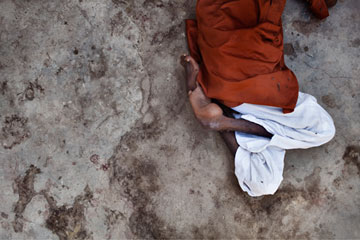
(3 of 5)
Fighting these periodic outbreaks gets expensive, which is why eradication is the most cost-effective goal. Rotary and other groups calculate that $1 billion spent per year over the next few years to extinguish the last fugitive strains of polio could save up to $50 billion over the next 20 years, both in treatment costs for infected children and in the perpetual, hold-the-line vaccination programs that must be maintained as long as the virus is at large. Vaccinations against smallpox have not been a burden on medical balance sheets since the late 1970s.
"Once polio is gone, you eliminate those costs forever," Gates told TIME. What's more, the medical infrastructure put in place to get the polio vaccine out there--the supply chains, volunteer networks and innovations like GPS trackers on vaccine shipments to prevent them from going astray--can then be repurposed to fight other diseases. But the polio battle must first be won. And even if that battle has already led to bloodshed in the field, it's at the submicroscopic level, down where the viruses live, that the truly consequential war is being waged.
The Half-Century Fight
It was in 1955 that epidemiologist Thomas Francis Jr., who led the massive field trial of Jonas Salk's polio vaccine the year before, stood onstage at the University of Michigan's Rackham Auditorium and announced the results. "The vaccine works," he said. "It is safe, effective and potent." That was the epidemiological trifecta scientists had been hoping for, and the six-inch headlines and global hoopla that followed were measures of the profound relief the world felt. In 1952, nearly 58,000 Americans were stricken by polio; by 1961, the figure was down to 1,312. That was the year before Albert Sabin's oral vaccine went into wide use. When it did, the U.S. numbers fell effectively to zero.
There are critical differences between the Salk and Sabin vaccines--differences that led to ferocious arguments when the men were alive, arguments that have continued long after their deaths. The Salk vaccine uses a killed virus to trigger the critical immune reaction and requires an injection. The Sabin vaccine uses a live, weakened virus that is taken orally, multiplies in the gut and spreads to the bloodstream, where, like the Salk vaccine, it teaches the immune system to recognize polio and go on the attack if it ever sees it again. The Salk vaccine costs up to $3 per dose today. The Sabin formulation costs less than 20¢ and can be administered with just two drops. "You could train people to do this," says Dr. John Sever, vice chair of Rotary's international antipolio drive. "If they could count to two, they could be an immunizer."
But the Sabin vaccine isn't as obvious a choice as it seems. Polio spreads via feces, and on a single passage through a single body, a live Sabin-vaccine virus can mutate from safe to deadly, infecting both the recipient of the vaccine and people close by. "These cases are rare as hen's teeth," says Dr. Bruce Aylward, WHO's chief of polio eradication, "but after you spend $10 billion and 25 years to eradicate the disease, you don't want a vaccine-related epidemic." (Hen's teeth, in this case, are 610 cases out of 2.5 billion vaccinated children since 2000, according to WHO--rare indeed.)
